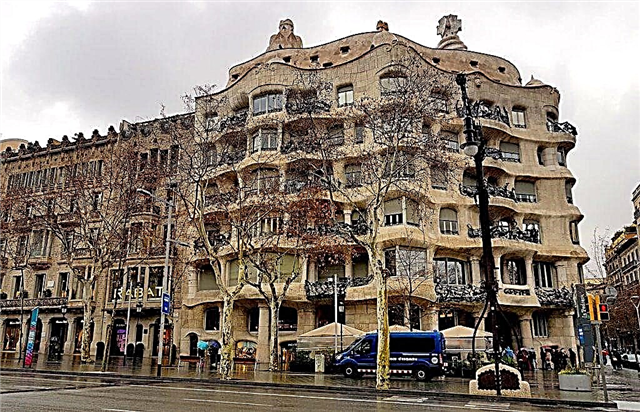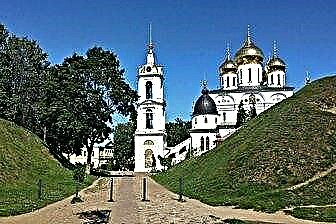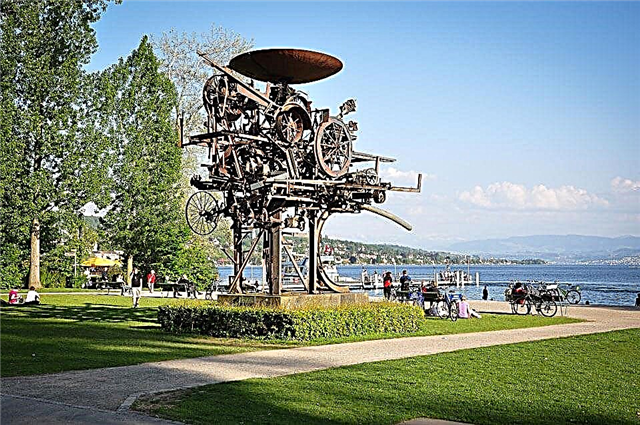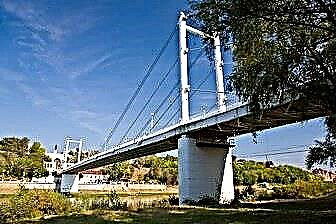Orenburg can offer tourists historical, cultural, ecological, pilgrimage, extreme and recreational programs. Visiting sights, numerous monasteries, jeep tours around the neighborhood, trips to the tracts and steppes of the Southern Urals, skydiving and river rafting are just a small part of what you can do in the Orenburg region.
There is also something to see in the city itself: Sovetskaya Street and the National Village complex, steeped in history, will be of interest to travelers who are fond of the past and who want to learn more about the culture and life of different peoples. Expositions of local museums will tell visitors curious stories and tell about little-known facts.

The best hotels and hotels at affordable prices.
from 500 rubles / day
What to see and where to go in Orenburg?
The most interesting and beautiful places for walking. Photos and a short description.
Pedestrian bridge across the Ural river
The first wooden bridge across the river was built in 1835. Every year, after the spring flood, it had to be repaired. The modern metal structure was built only in 1982. The bridge has a certain symbolic meaning, as it allows pedestrians to travel from Europe to Asia and vice versa. From the Ural embankment, you can climb to it by a wide staircase with a classic balustrade.

Sovetskaya street
The main tourist alley of Orenburg is 3 km long. On one of the sections, it is completely pedestrianized. A fascinating story can be told about almost every building located on this street: house number 1 is the aviation school, which Yuri Gagarin graduated from, house number 2 is the former residence of the military governors of the city, in house number 3 the Decembrists were exiled in the 1820s, and house no. 4 is one of the oldest buildings in Orenburg, built in the middle of the 18th century.

Cultural complex "National Village"
Museum and ethnographic complex, built in the 2000s at the initiative of the city authorities. It represents the national farmsteads of the peoples inhabiting the Orenburg region. These are Tatars, Kazakhs, Ukrainians, Bashkirs, Mordvinians, Belarusians, Armenians, Germans, Chuvash. On the territory of the complex there are museums of everyday life and culture, restaurants of national cuisine, libraries with literature in different languages.

Museum of the History of Orenburg
The Museum of Local Lore, located in a 19th century building, which itself has considerable architectural value. It is made of red brick in the style of a European castle. It is interesting that such an original project was created by a self-taught serf architect I. P. Skalochkin. The diverse exposition of the museum covers the period of the history of Orenburg from the earliest eras to the New Age.

Orenburg Museum of History and Local Lore
The first local history museum was founded in 1830 by the order of the military governor. Later it was disbanded several times, distributing the collection to other institutions. It was last opened in 1994 after years of restoration work. As the name suggests, the expositions are dedicated to Orenburg and the region: everyday life, culture, identity of peoples, history and nature.

Orenburg Museum of Fine Arts
The art exhibition appeared in 1960. It was placed on the territory of a mansion of the early 19th century, built for the meetings of the city council. The collection is based on a collection of works by the itinerant artist L.V. Popov, a native of Orenburg. In the museum, you can see paintings by Russian and European artists, created from the beginning of the 16th century. Among other things, ethnographic, decorative and applied exhibits and sculptures are presented here.

Drama Theater named after M. Gorky
Residents of Orenburg began to attend regular theatrical performances from the second half of the 19th century. The performances took place on the territory of the restored stone arena. At first, the plays were not popular due to the low professionalism of the troupe, but gradually the repertoire improved and the acting became more skillful. In the middle of the 20th century, the old building was completely rebuilt. In this form, it has survived to this day.

Tower with chimes
The tower adorned Sovetskaya Street in 1997. The watch was made almost a decade earlier, but it was never installed due to the fact that the project was frozen. The site was finally completed in 2005; the restored clock was installed on the facade in 2013. The structure is 40 meters long; a spire with a weather vane in the form of a bird spreading its wings is placed on the peaked roof.

Water tower
The original engineering building of 1904, erected for purification purposes and providing the residents of Orenburg with drinking water. The building is located in the center of the city; its appearance contrasts sharply with the surrounding buildings. Due to the fact that the tower was recognized as an architectural monument and provided it with proper care, it has survived to this day unchanged and has become one of the most popular attractions.

Gostiny Dvor
Gostiny Dvor was built with the aim of organizing a suitable space for developing trade with the peoples of Asia. The two-storey building in the classicism style could accommodate up to 150 shops. The complex still performs its original functions - modern shopping areas have replaced the merchant shops. The complete reconstruction of Gostiny Dvor was carried out in the 2000s.

Nicholas cathedral
Orenburg Cathedral, founded in 1886 by local Cossacks. The building survived the 20th century, as it was not destroyed during the persecution of religion (the authorities limited themselves to closing). Since 1942, the archive of the NKVD organs evacuated from Moscow and Leningrad was located here. The temple started working again in 1944, a decade later its walls were painted anew, in 1980-90 the rear walls were restored and expanded.

Caravanserai
An architectural complex designed by A. Bryullov in the eclectic style with elements of the oriental style. It was built on voluntary donations for the administration of the Bashkir army. Hotels, schools, workshops and a mosque were located here. The building got its name "Caravanserai" due to its Asian appearance and corresponding color. In the middle of the 20th century, a planetarium worked in the prayer hall; today, a mosque is located here again.

Monument to Pushkin and Dal
The monument was installed in 1998 for the next anniversary of Orenburg. The authors decided to place on one pedestal two outstanding literary figures, whose creativity and work gave a powerful impetus to the development of the Russian language, significantly enriching it and expanding its boundaries. A. Pushkin wrote his "Captain's Daughter" after visiting Orenburg, V. I. Dal spent several years in the city as an official under the military governor.

Monument to Yuri Gagarin
The famous cosmonaut graduated with honors from the local flying school, although at some point they even wanted to expel him. A monument in his honor was erected in 1986 on April 12, Cosmonautics Day. The monument is a 4-meter-high figure of Gagarin, dressed in a spacesuit and with his arms directed towards the sky. A little behind there are two steles, symbolizing a rocket heading towards the unknown and frightening Cosmos.

Monument to the Orenburg Cossacks
The monument is located not far from the Nikolsky Cathedral on the territory of the city square. It was installed in 2007. The sculptural group is dedicated to the Cossacks who played a key role in the defense of the eastern borders of the Russian Empire during its active expansion. The monument represents a gallant warrior on horseback.All the details of the image are drawn so clearly and realistically that it seems as if the sculpture is about to come to life.

Monument to V. Chkalov
After V. Chkalov's death, Orenburg was renamed in his honor to perpetuate the memory of the test pilot (while Chkalov himself was never in the city). The monument was erected in 1953 on the banks of the Urals. The bronze sculpture was cast in Moscow and erected on a granite pedestal. The total height of the structure is 13 meters. The monument stands surrounded by a flower bed and adorns the embankment of the river.

Elizabethan gate
In 1755, Empress Elizabeth presented Orenburg with a stone gate, symbolizing the entrance from Europe to Asia. They represent two massive pillars with sculptures of angels in niches and a crossbar with a bas-relief connecting them. Initially, they were installed on the rampart, and then they were transferred to the bank of the Urals. Over time, the bas-relief was removed and deposited in a museum. In 2008, the gate was restored.

Stele "Europe-Asia"
Many obelisks have been installed in the Urals, marking the conditional border of Europe and Asia, but the very first stele was installed in Orenburg in 1981. It is a tall square pillar 15 meters high, crowned with a spherical structure, to which a cobbled alley with flower beds, benches and lanterns leads. The structure is clearly visible from the road bridge across the Urals.

Frunze Garden
The garden was founded in the late 1930s, but during the Second World War, all plantings were destroyed. They were revived in 1948, and in 1973 they underwent a complete reconstruction, practically breaking a new one on the site of the old square. In 2005, an exhibition complex and an open-air museum "Salute, Victory!", Consisting of expositions of military equipment, weapons and sculptural groups, was solemnly opened on its territory. After this event, the garden was revived again.

Park "Poplar"
City amusement park with many modern attractions for visitors of all ages. This is one of the best places in Orenburg for a weekend getaway with the whole family. The park has restaurants with summer verandas, cafes, a cinema, and concert venues. For convenience, free parking is available at the entrance. Topol is a cozy and well-groomed place and a real green oasis.












